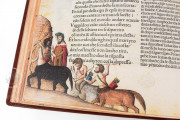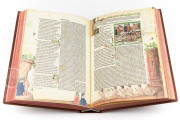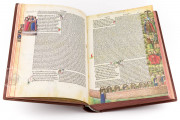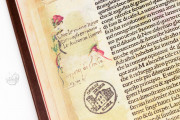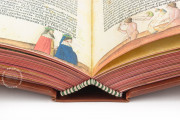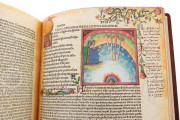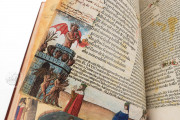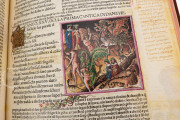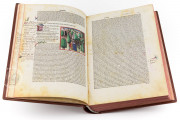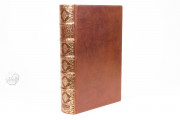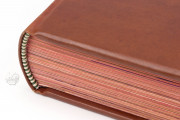The Casa di Dante's incunabulum of the Divine Comedy is one-of-a-kind and is truly one of the best editions ever produced of Dante Alighieri's defining work.
Dante Alighieri, Father of the Modern Italian Language
Universally known as one the greatest poets of all eras and schools of literature, Dante Alighieri left us the highest testament to Western Middle Age civilization, to which the modern era is deeply indebted.
«The work of Dante – stated renowned scholar Erich Auerbach (1892-1957) – is the attempt of synthesizing the whole universal reality in a both poetical and systemic way» (Figures, 1939).
Italy owes Dante Alighieri for his ingenious choice of adopting the Italian vernacular at a time when Latin was still the standard for literary work. Dante modeled the Italian language adapting it to the needs of literary writing, thus heavily influencing formation of the Italian language as it is spoken today. Thanks to his remarkable achievement – for which he is properly recognized as the «father of Italian language» – his Divine Comedy is the only medieval masterpiece which is still readable in the original version, without translation.
The Divine Comedy, a Journey to God
As we know, the "Divina Commedia" depicts a journey: a sublime report of the redeeming passage conducted by Dante after being lost in the “selva oscura” (dark forest). A journey undertaken with the guidance of, first Virgil, then Beatrice, and, at the last stage of his quest, Saint Bernard, who leads him to the bliss of paradise.
During his trials, Dante Alighieri passes through the three realms of the afterlife: Hell, the place of eternal suffering, where sinners receive retribution for their deeds; Purgatory, where repentant sinners make restitution for their sins and purify themselves in order to ascend to Heaven; and, finally, Heaven itself, containing the blessed souls (those who accomplished Purgatory's purification), along with the saints and all those divine beings deserving the bliss of the Empyrean (God's heaven).
A Successful Best-seller in Manuscript and Printed Copies
The Divine Comedy immediately received a receptive audience, as proven by the dissemination of more than 2000 manuscript copies prior to 1480, when the spread of printing technology radically changed the way of reading and laying out texts. Of those manuscripts, often provided with glosses, notes or extended commentaries, and sometimes with precious iconographic settings, around 800 are left today: the rest are lost, along with Dante's autographs.
Such a huge textual tradition caused serious problems in the attempt to philologically restore the original readings. This was due to each copyist making their own mistakes, which were subsequently repeated and exacerbated by others, with the multiplicity reflecting the massive number of copies.
The printed editions of the Divine Comedy tried to remedy such a specific textual condition, by preparing a text somehow "amended", or however reviewed, that means generally more standardized and readable on the page. The reviewed text was often equipped with commentaries and decorated with copperplate and wood engravings.
The 1491 Venice Edition by Pietro Piasi, with Glosses of Cristoforo Landino
The editorial fortune of the "Divina Commedia" (thirteen editions within nineteen years, between 1472 and 1491) reached its apex with the monumental Venetian edition published by Pietro Piasi on November 18, 1491. It is a big in-folio (31.5 x 21.2 cm), with large page margins holding the text of the poem "amended" by Pietro da Figino (a 14th Century Dominican scholar), and Cristoforo Landino's recent commentary (Florence 1481).
The book is enriched with 97 engraved vignettes, three large full-page wood engravings included within decorated borders, and very fine initials. The volume holds also (fols. r2V-r6v), for the first time, the fifteen “canzoni” of Dante not included in the “Convivio”.
Hand-written Notes and Decorations
A copy of such a precious and rare edition was later re-elaborated by a learned reader (identified for a long time as the text editor declared in the print, Pietro da Figino), who added dense handwritten notes in the margins and supervised the execution of a rich iconographic apparatus along the three “cantica”: it consists of more than 400 pages filled with wide figures, vignettes and high-quality decorations, framing Dante's text, Landino's commentary and forming a suitable pictorial commentary to the poem.
The book's decoration – ascribed to Antonio Grifo (Venice, ca. 1430-1510) – was executed shortly after the printing, in homage to Galeazzo Sanseverino, son of Roberto, commander in chief of the Sforza army, and, since 1496, married to Ludovico il Moro's daughter, Bianca.
With this exception, nothing else on the history of the volume is known until its appearance on the antiquarian book market in 1927, from where it was purchased by the then Italian minister of Education Pietro Fedele, representing the Italian government, and subsequently offered to the Casa di Dante in Rome. There it remains today, as "the most precious item" in an already prestigious library.
Binding description
Binding
Hand-bound in leather, with colored headbands and edges, gilded and blind-tooled spine.
We have 1 facsimile edition of the manuscript "Divina Commedia 1491 Illustrated Incunabulum": Comedia di Dante con Figure Dipinte facsimile edition, published by Salerno Editrice, 2014
Request Info / Price




